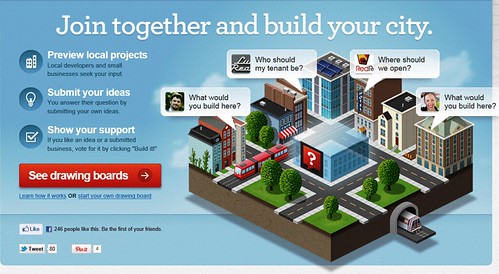Want to build development that the community will welcome? Ask them what they want.

Posted April 16, 2012 at 1:30PM
If you’re in the business of trying to make communities better, and supporting great, green revitalization that will strengthen central cities, you know only too well how change can frighten current residents. Not entirely without reason, people fear development, especially when someone new shows up with an idea. Heck, a friend of mine is having trouble beating back opposition to a nice pizza place in a vacant commercial property in his neighborhood. It can be hard to stay optimistic when even pizza is controversial.
There may be something very human – maybe even Darwinian – about our tendency to resist ideas that come from, you know, other people. (I guarantee that if the idea for universal health care based on all citizens buying health insurance had come from within the Republican Party rather than from the Dems, Republicans wouldn’t oppose it so strongly. Oh wait . . .) So, how do we empower communities to own ideas for development?
Two young developers in DC have come up with a new way to solicit opinion on what to do with commercial property in an up-and-coming neighborhood. First they bought the property, on H Street, NE, where the first segment of the new DC streetcar will run. Then they set up a website called Popularise to solicit community ideas on what people would like to see in that space, and hung a banner over the property, saying “What would YOU build here?” and directing people to the website. People can submit their own ideas to th e site and/or vote and comment on those submitted by others.
e site and/or vote and comment on those submitted by others.
According to a story written by Shilip Paul and posted on Urban Turf, the inquiry is attracting a lot of interest and some intriguing ideas, from a pizza kitchen (!) to a craft doughnut shop to a pisco bar. The leading vote-getter as of this writing is a clothing store, but pizza isn’t far behind.
That’s intriguing enough. But developers and brothers Ben and Dan Miller, founders of Popularise, are clearly thinking beyond the H Street project. They believe their new platform could enable an entirely new form of community-driven real estate, in Washington and elsewhere. Ben Miller explains on the site’s blog:
“After working in real estate for years, we’ve developed an intimate understanding of how great neighborhoods get turned into vanilla clones. And we want to make it stop happening.
“We created Popularise as a new way to approach developing authentic places, by using the web to give development power back to local residents like you . . .
“Basically, real estate development has become dominated by huge investment funds and public real estate companies—most of whom have more than a billion dollars in assets.
“While this money brought a lot of benefits, these corporations just aren’t based in the neighborhoods they develop. They’re out of touch with what people in those neighborhoods want, need, and use . . .
“The good news is that, just as the web transformed the media industry, so it can transform the real estate industry.”
The Millers and their partners in Popularise intend to grow the concept carefully, inviting other developers and users to take advantage of the platform. In a section of the site called “How it Works,” they explain the process:
- A local developer or business starts a drawing board by posting a real project that they are building in your city. They frame the question and ask for your input.
- You help them with their project by submitting ideas that answer their question. You can involve your friends and neighbors and campaign for ideas.
- If you like an idea or want to support a submitted business, vote for it by clicking "Build it!"
- Builders get better ideas and more information. You get places you want and help build a better city.
I love the idea. It will be especially interesting (and perhaps telling) to see whether it can catch on not just with the hyperconnected 20- and 30-somethings that form the site’s current base but also with older, more entrenched residents who tend to fear outsider-driven change the most. If it can, they will have a winner.
Here’s a short video segment than ran on local TV, and that gives a sense of the project and the first neighborhood in which it is operating:
Related posts:
- The citizen as expert: grassroots planning Down East (January 6, 2012)
- Knowing when it's green: A Citizen's Guide to (LEED for) Neighborhood Development (May 25, 2011)
- DC's great revitalization story: Columbia Heights (video) (July 14, 2009)
Move your cursor over the images for credit information.
Please also visit NRDC’s Sustainable Communities Video Channel.

